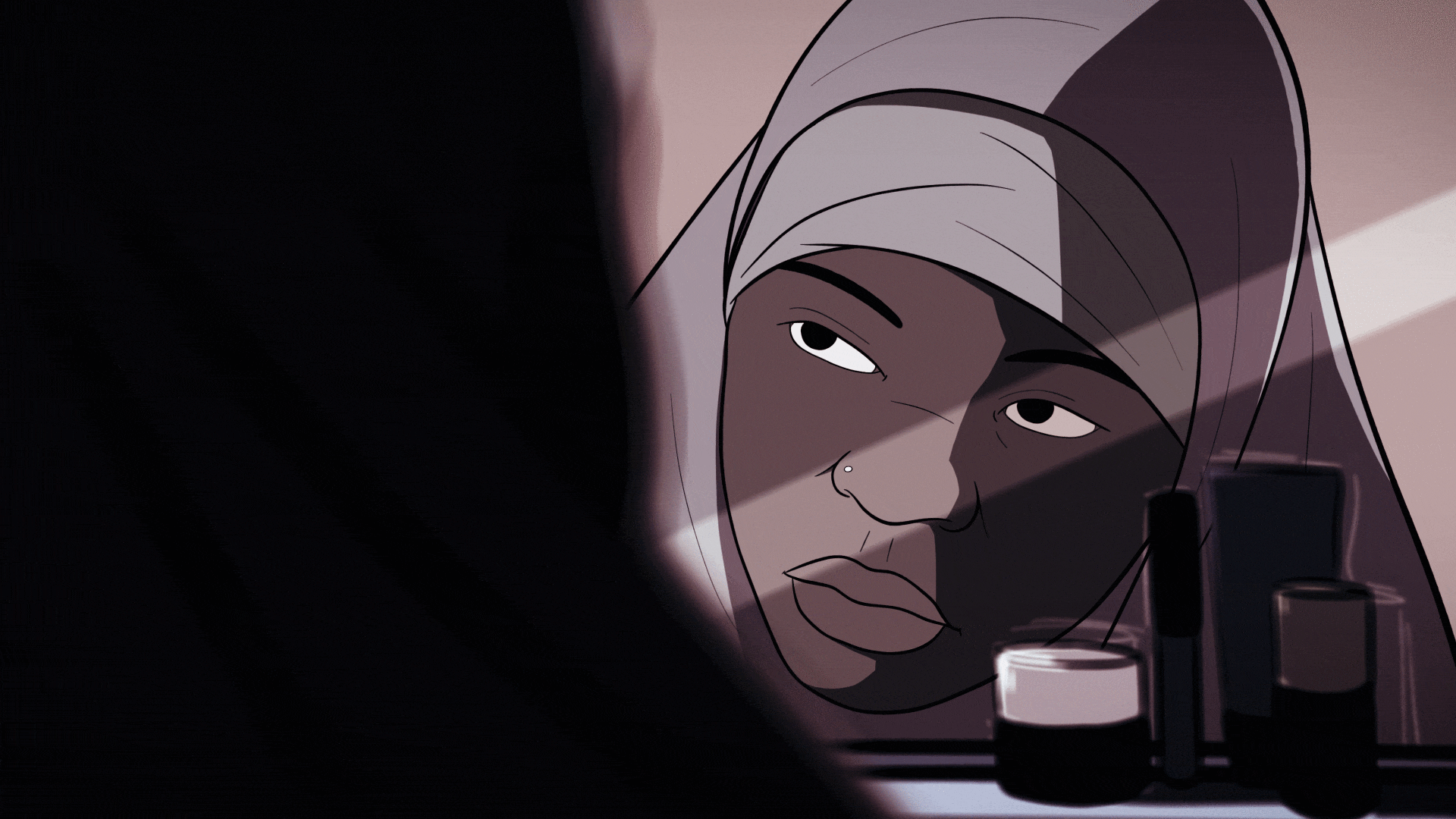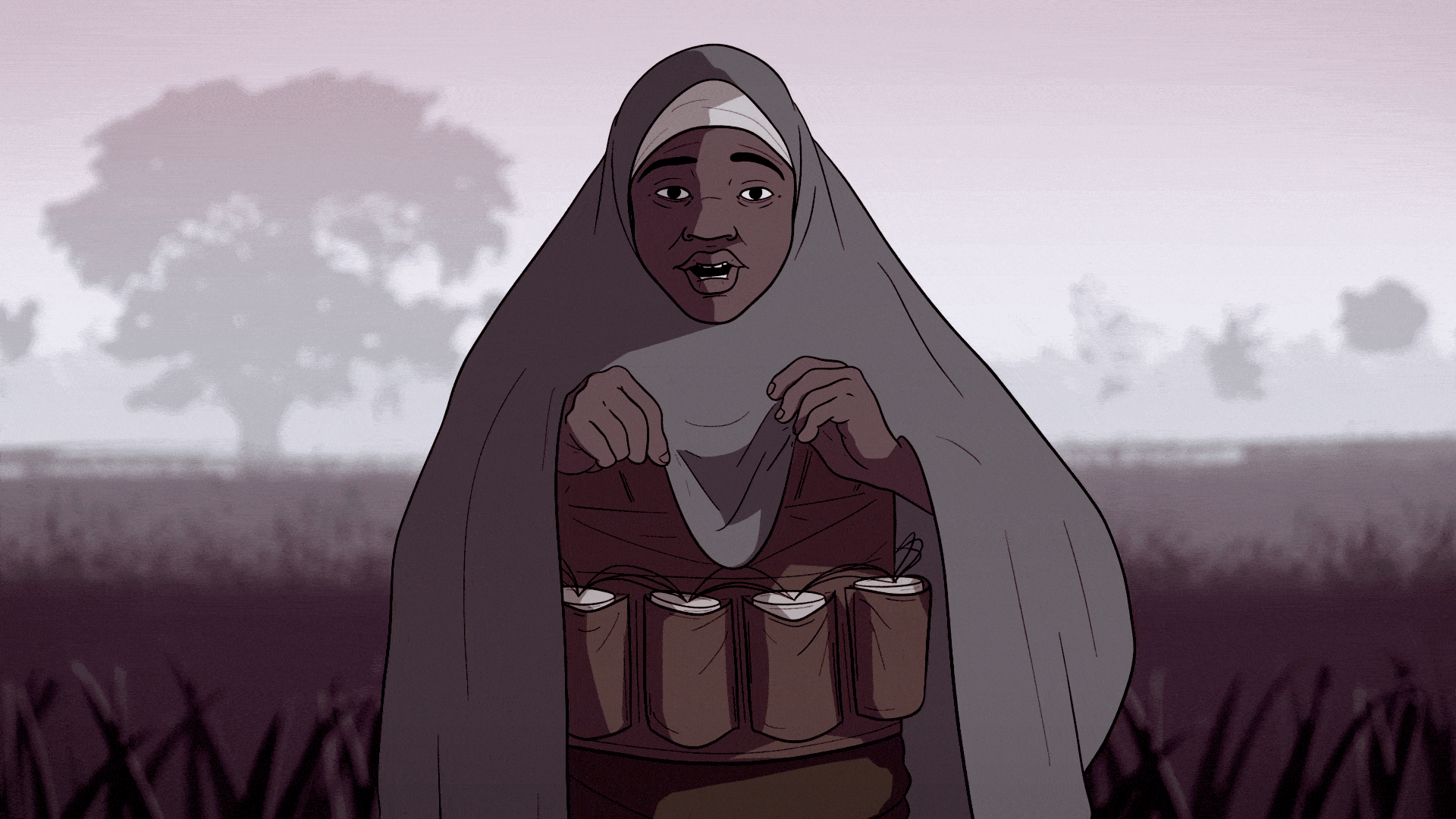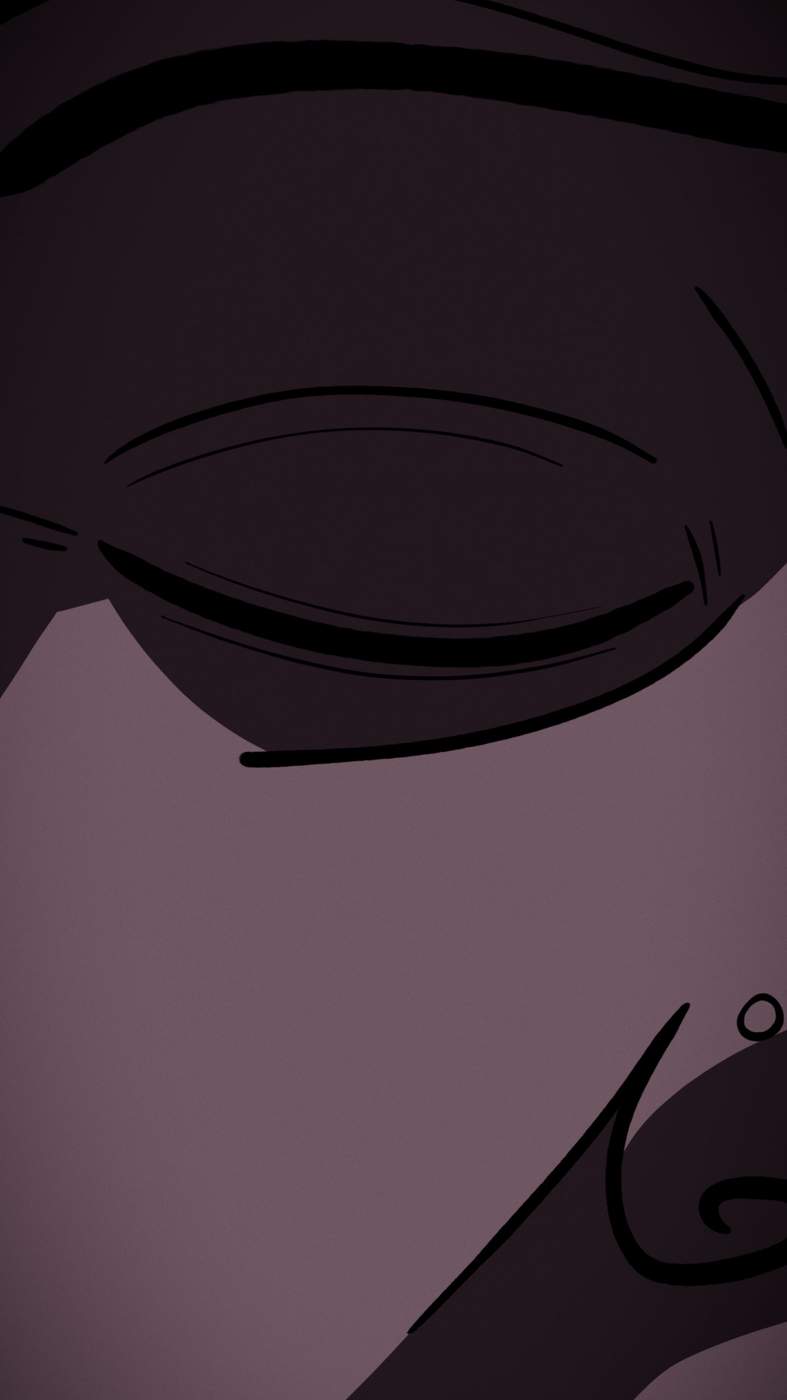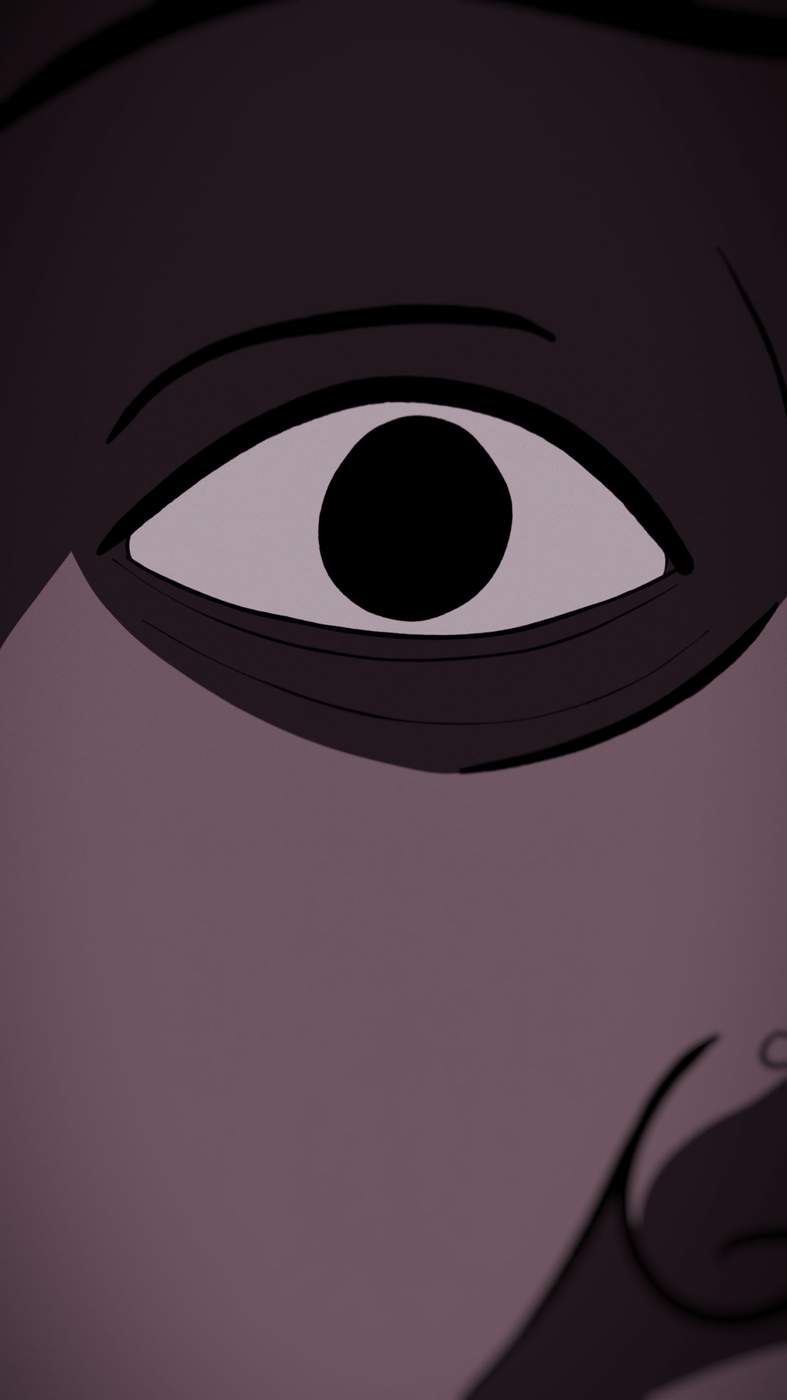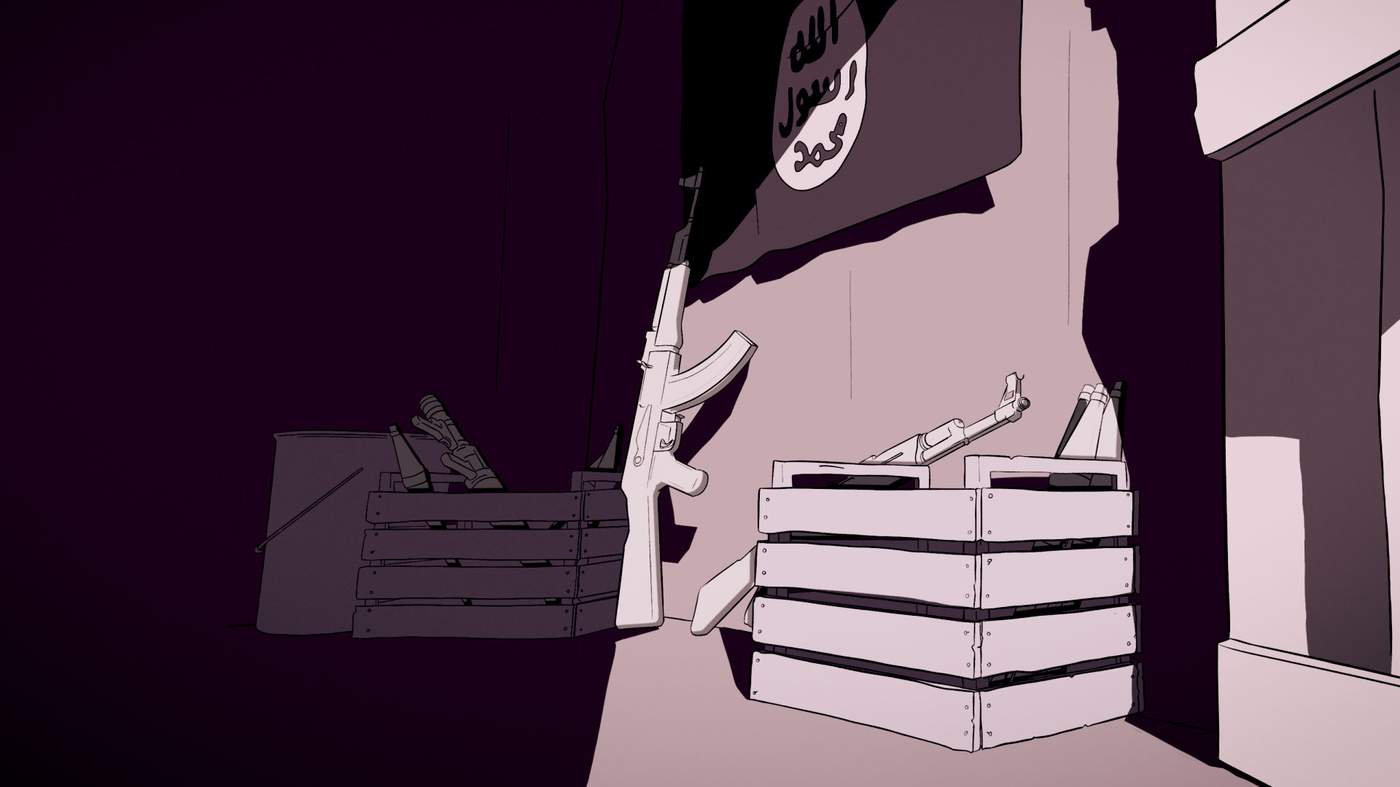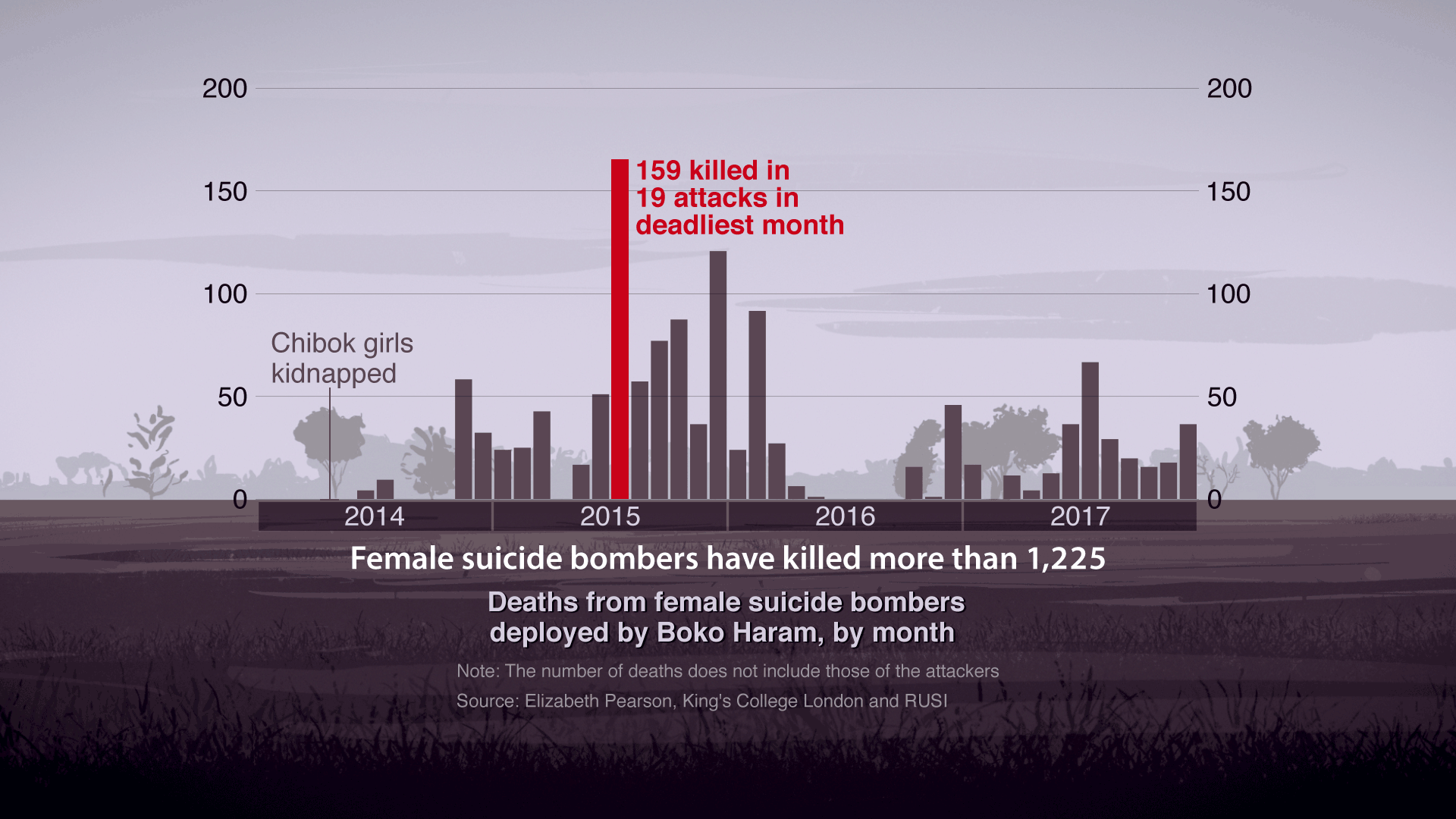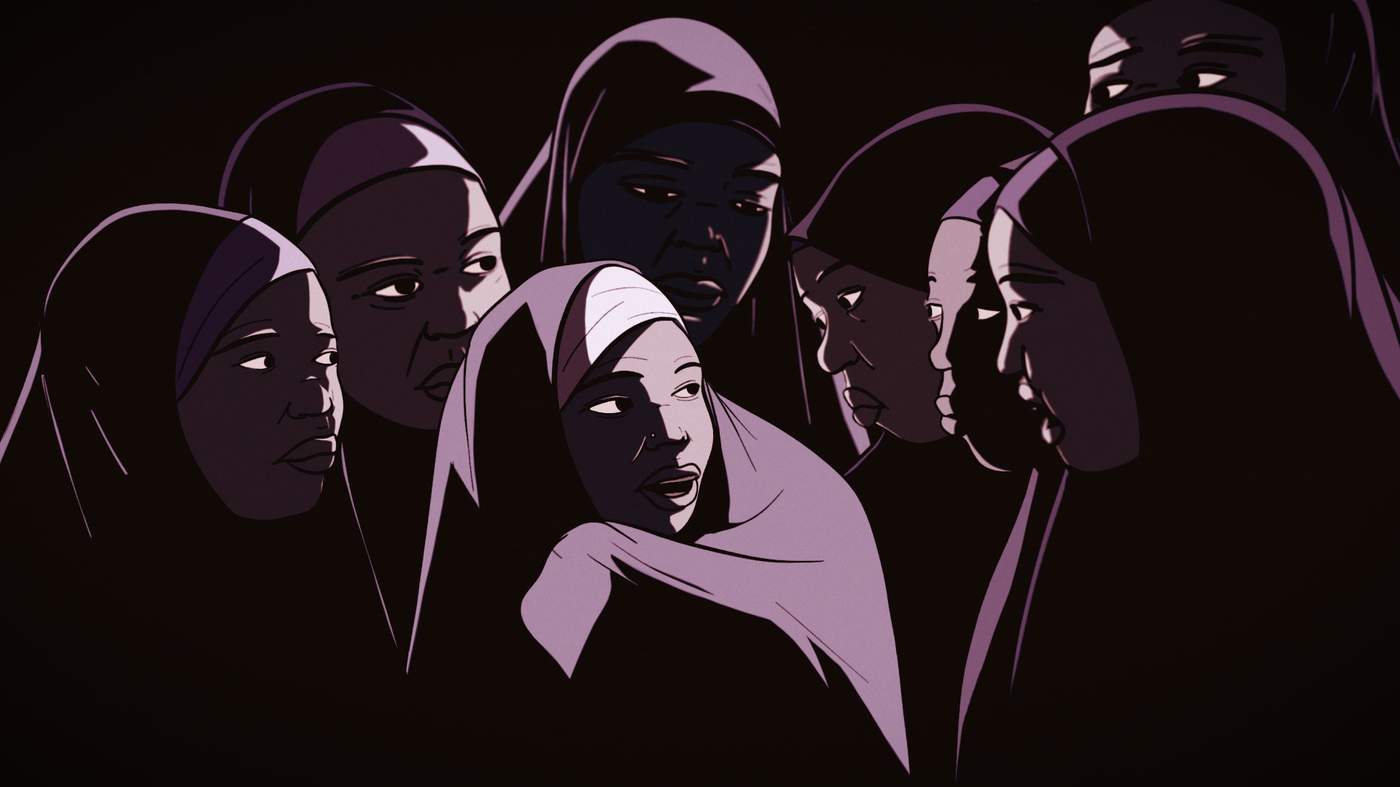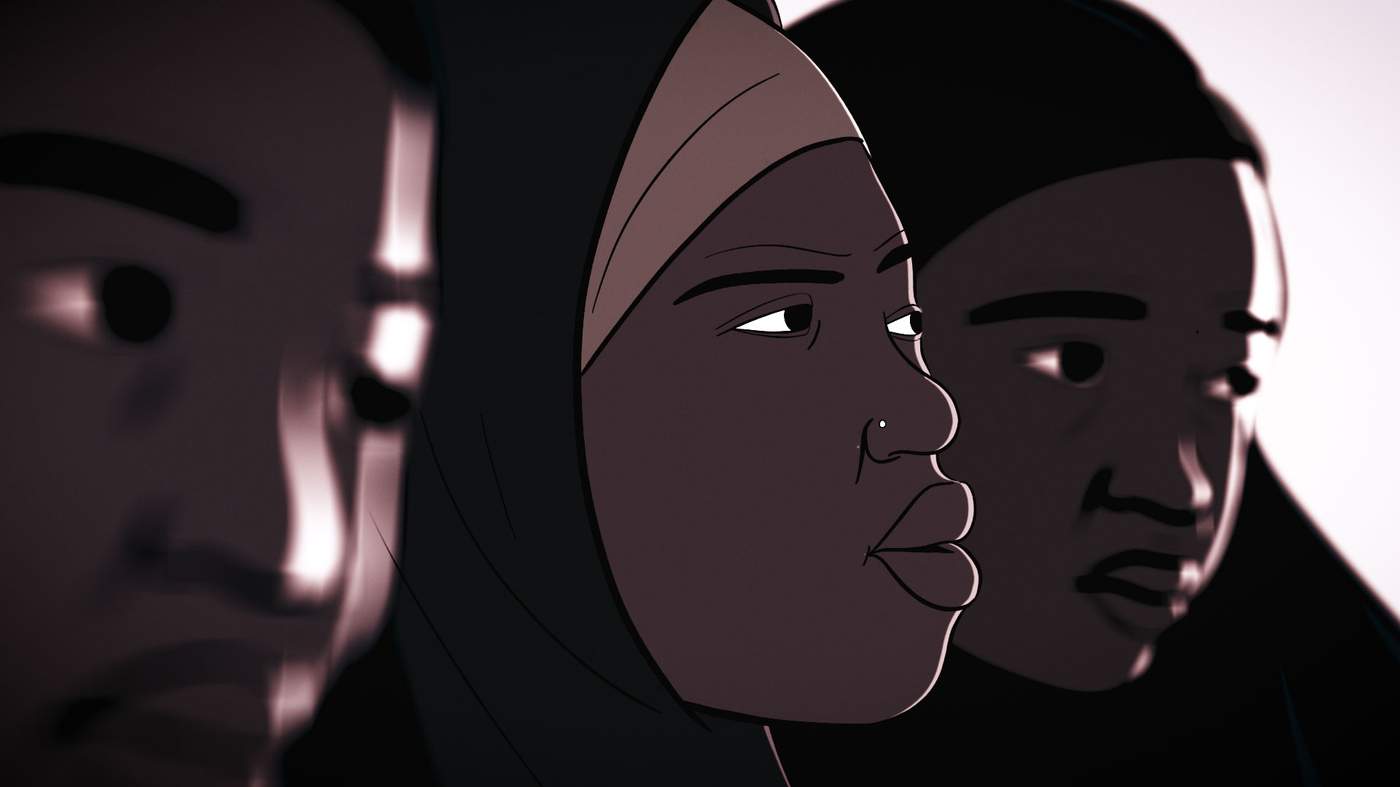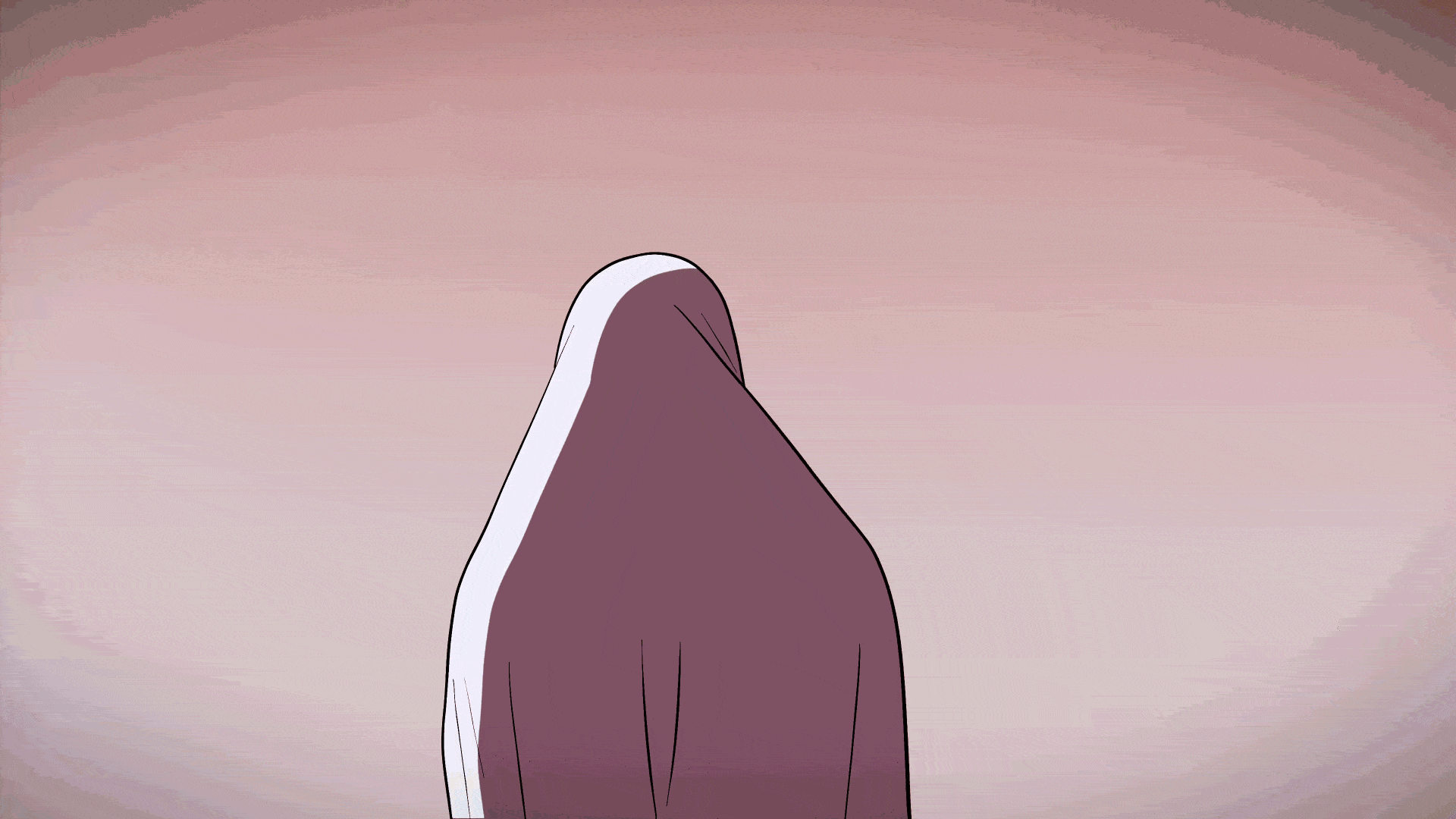Falmata is getting a full beauty treatment - a thick paste of henna, with its delicate pointed swirls, adorns her feet.
While it dries, a woman is battling with her hair. Comb in hand she’s stretching and straightening Falmata’s tight curls.
“We were allowed to choose any style for the hair and the henna,” remembers Falmata. “We got the henna to dye our hands, legs and sometimes even the neck.”
Falmata knows she is going to look beautiful. But there’s a deadly consequence.
Once she's been made up, a suicide bomb will be attached to her waist.
Falmata is one of hundreds of young women, most of them teenagers, who have been abducted by militants in Nigeria and forced to carry out missions for them.
Remarkably, she survived.
She was just 13 when she was snatched by two men on a motorbike while she was walking to a relative’s house near the border with Cameroon.
They rode for hours - Falmata pinned between the two men - leaving the road and travelling deep into a forest.
Eventually they reached their destination - a huge, makeshift camp. Falmata had no idea where she was.
“There were many tents and thatched houses,” she says, almost whispering.
“The young girls were put in the tents. There were nine in mine and we had to sleep on big mats.”
The camp belonged to Boko Haram, the militant group that has been fighting a long insurgency aimed at creating an Islamic state in northern Nigeria.
“At first I wanted to escape but there was no chance,” she says. Men were stationed all around the camp to catch anyone who tried to leave.
It wasn’t long before Falmata was forced to make a choice - marry a fighter, or go on a “mission”.
She refused to get married. “I told them that I was still too young,” she says.
But she had no idea what the “mission” was.
At first Falmata found the camp frightening.
Conditions were rough, and the captives - women, girls and boys - feared being caught up in the war between government forces and the militant group.
Particularly the women.
“We were scared that soldiers would storm the camp at any time and not spare us, the women, because they would think we were the fighters’ wives,” says Falmata.
If a helicopter or plane appeared in the sky, the captives would panic, certain that the camp was about to be bombed by the Nigerian forces.
“When we saw them many of us cried,” she says. “Some would even soil themselves.”
Life in the camp was incredibly monotonous.
Wake up, pray, eat, clean, pray, eat, and clean - all day long.
There were daily religious lessons, long hours reciting verses from the Koran.
Falmata says that while she hated everything in the camp, she welcomed the religious teaching.
One day, the monotony of her daily routine was interrupted.
Falmata was approached by armed men and instructed to prepare herself for something important.
Her feet were to be decorated with henna. Her hair was to be straightened.
Was she being prepared for her wedding, she wondered. Was she going to be married off to a fighter after all?
“My friend Hauwa had agreed to get married as a way of trying to stay alive,” Falmata says. “She wanted to find a way to escape.
“Other girls hated her for getting married and so did I at first. But then I understood her and felt sorry for her because she was unhappy.”
The women helped Falmata get ready for whatever was in store for her.
“All I was thinking was, ‘Is it for marriage or what?’ But you can’t ask why you’re getting this done. Instead friends just console you and tell you to be patient.”
Two days later, she was approached by fighters. A bomb was forced around her waist.
Sanaa Mehaydali is thought to have been the first female suicide bomber in modern history.
The 16-year-old killed herself and two Israeli soldiers in a suicide attack in southern Lebanon in 1985.
Since then, militant groups such as Hezbollah, the Kurdish PKK, Tamil Tigers in Sri Lanka, Hamas and Black Widows in Chechnya, have all used women and girls to carry out suicide attacks.
But Boko Haram has outstripped any one group by far in the scale of its brutality, according to Elizabeth Pearson, associate fellow at the Royal United Service Institute in London.
She estimates that hundreds of young girls have been forced to carry out attacks in the past three years, in Nigeria, Cameroon, Chad and Niger.
By the end of 2017, 454 women and girls had been deployed or arrested in 232 incidents, Pearson says. The attacks killed 1,225 people.
Pearson is the author of a study about Boko Haram’s use of female suicide bombers.
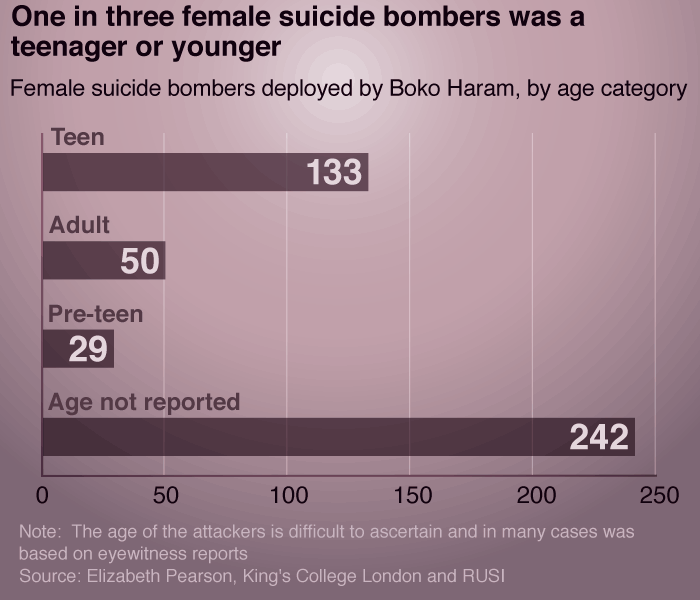
The first time a girl was forced by the group to carry out an attack was June 2014.
The bombing of a military barracks took place shortly after the notorious kidnapping of 276 schoolgirls, who became known as the Chibok girls.
The mass abduction from a school dormitory in Borno state caused an international outcry.
“[Boko Haram] got a lot more publicity with this attack than they did with previous suicide attacks using young boys. That’s why they kept using girls,” says Pearson.
Fatima Akilu is a psychologist and executive director of the Neem Foundation which gives mental health support to communities affected by Boko Haram.
She says at first it was mainly young men who carried out suicide attacks - ones who were inspired by Boko Haram’s ideology and rhetoric.
“They mostly volunteered because they truly believed that they were going straight to paradise,” she says.
“But when the [Nigerian] military offensive got more intense, the pool of young men volunteering dropped significantly, so Boko Haram started kidnapping and coercing young girls for suicide missions.
And there seems to be no age limit to this cruelty.
In December 2016, two girls said to be aged seven or eight were used in a double suicide bombing in a market in north-east Nigeria.
After being abducted for a second time, Falmata was taken back into the forest. This time to a different camp.
Had her captors known she had just abandoned a suicide mission, they would probably have killed her.
Life at this camp was much the same as the other.
It was the same daily cycle - eat, clean, pray, recite Islamic verses for hours, sleep.
According to the Neem Foundation, women and children rescued from militants often adopt Boko Haram’s beliefs while under their control.
“A lot of the people we meet who have been in these camps haven’t had much education before, neither Western nor Islamic,” says Akilu.
“Many actually learn about the Koran for the first time while they’re in Boko Haram captivity.
“They hold hundreds of people in their camps, and there is really nothing to do to keep them busy all day, so they end up having four or five hours of religious teachings. They find that religion is a coping strategy.”
After a month or so of being in the new camp, Falmata was again presented with a choice - marriage or mission.
Again, she refused to marry. But this time she was wiser when it came to the mission.
She was painted with henna and given a beautiful dress and a headscarf. A belt of explosives was attached to her stomach.
But this time she ran into the forest as soon as the fighters left her.
“I met some farmers and asked them to help me remove the belt. I told them I was being forced to carry out a mission, but that I didn’t want to do it,” she says.
Falmata left the farmers and spent several days in the forest trying to find her way back to Maiduguri, and to her family.
On the way she joined a group of hunters who allowed her to travel with them across the woods.
But the hunters were attacked by Boko Haram fighters. In the confusion, Falmata managed to slip away into the forest.
“I didn’t know the forest. Every little sound would scare me, so I kept moving. I’d sleep on trees when I could,” she says.
“I think I spent a whole week without food. I would drink stagnated water and also use this water to wash my hands and feet when praying.
“I would pray two or three times a day whenever I could find water. I was so scared, but God helped me and I reached a town.”
A local family gave her shelter for a few days and then helped her to get back to Maiduguri.
For months after her escape, Falmata was in hiding. She was afraid the authorities would find out about her and she would be arrested.
Fatima Akilu has met a number of youngsters like Falmata. She says that when they return, they need time to re-establish family bonds.
“She’s been away from her family for too long and she might have changed during this time. But her family may also have changed and have traumas of their own.”
Like many families in Nigeria’s north-east, Falmata’s was split up by the fighting.
She is now living with her mother in a camp for displaced people. Conditions are difficult, but at least no-one knows her story.
Girls like Falmata face an incredibly difficult time.
Most of those who don’t detonate their bombs are captured by the security forces and taken to a “deradicalisation centre”.
These centres are run by the army and very little is known about what happens there.
In mid January, the army said they had released the first group of “deradicalised” people, although it’s unclear where they are now.
The few who do manage to slip back into their community unnoticed remain in the shadows.
They are referred to by some in their communities as “annoba”, which means something like “epidemic”.
Any girl that spent time with the militants will be seen as Boko Haram by many people, says Akilu.
“I think that people in these communities tend to look at the act, rather than the girl.
“They see the girl and think, ‘This is a young person who is willing to eliminate our whole community, how can we then take her back?’”
She says the girls also remind them of the terror that they have lived through.
Boko Haram is considered one of the deadliest militant groups in modern history. Since 2009 they have killed more than - including Muslims - in Nigeria alone.
Many more have been killed in Cameroon, Chad and Niger. The fighting has displaced more than two million people.
“Almost 90% of the communities in the north-east [of Nigeria] have been affected by Boko Haram. Either they have lost loved ones or entire families,” says Akilu.
“So when the girls come back it’s almost like a secondary trauma. There’s a big problem with stigma.
“We don’t really spend enough time looking at it from the point of view of the girls, and see them as the victims they are.”
The second time Falmata had a suicide belt strapped to her, she was 14 years old.
She hadn’t seen her family for more than a year.
She had been imprisoned in extremist camps and subjected to heavy religious indoctrination.
She had tasted freedom, but this would turn out to be short-lived.
So why didn’t she detonate her suicide belt and end it all?
“I wanted to live,” she says.
“Killing is not good. It’s what my family taught me and what I believe in too.”
Credits:
Authors: Vladimir Hernandez & Stephanie Hegarty
Illustrations: Charlie Newland
Graphics: Zoe Bartholomew
Data Journalism: Nassos Stylianou
Online Producer: James Percy
Online Editor: Kathryn Westcott
Built with Shorthand
All images subject to copyright
